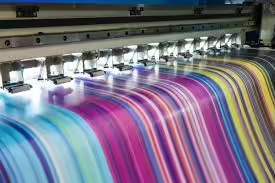The print industry is a fantastic sector to work in—with a turnover of £14 billion and a gross value added of £5.5 billion, print in the UK employs around 112,000 people in 8,000 companies. There are plenty of employment opportunities in the sector. So if you’re looking to start a career in the print industry but lack experience, you’re in luck. This guide provides you with a basic overview of key print industry concepts, such as paper types, covers, lamination, binding, and print file setup, the essential components of brochure, magazine and booklet printing. So, let’s get straight into it!
Paper Types
For your interview, you need to know four of the most common paper types:
Silk: The most popular paper type, which has a smooth finish and is seen as a default choice.
Gloss: This paper type has a shiny finish which adds saturation to images.
Uncoated:
Recycled: An eco-friendly paper option with a rough texture, which is perfect for printed marketing materials such as brochures, business cards and booklets.
You also need to know the basics of paper weight, the measure of paper density, which is expressed in GSM (grams per square metre). The higher the GSM, the thicker the paper. For example, printer paper typically has a GSM of 80, whereas business cards are usually 200 GSM. If you're preparing to work with laser printing or multifunction devices, it helps to understand what type of printer uses toner—knowing this can give you an edge when discussing equipment and supplies in a print industry interview.
Covers Lamination
Lamination involves bonding a very thin layer of plastic to paper surfaces to protect it from damage, such as fading, tearing and moisture. But that’s not all—it also improves the appearance of documents by adding an aesthetically pleasing shine.
There are several lamination options available, but the most commonly used are gloss and matt:
Gloss lamination: This type of lamination enhances the vibrancy of colours and adds depth to photos, giving documents a highly polished look.
Matt lamination: This type of lamination results in a non-reflective surface but still offers a sophisticated look. It is commonly used for postcards and business cards.
Gloss and matt lamination offers protective benefits for printed marketing materials, including protection against tearing and moisture.
Binding
The three most commonly used paper types for booklets, brochures, and magazines are stapled, perfect and wiro binding. Let’s explore each binding type in more depth:
Stapled binding: Stapled binding is a cost-effective method used to create documents between 8 to 64 pages. The binding method involves folding pages in half and stapling them together along the fold.
Perfect binding: This common binding method creates sleek printed materials such as catalogues, magazines and books. The process involves attaching pages along a spine using a strong adhesive and works best for documents with over 64 pages.
Wiro binding: Wiro binding is a method commonly used to create booklets, calendars and notebooks. The process involves punching holes in document pages and inserting a wire through the holes, enabling users to lay the printed materials flat on surfaces.
Print File Setup
Print files contain the digital marketing material design. To reduce the chance of costly printing errors, you need to ensure that digital files are set up correctly before they are sent to print. There are several key elements you must include:
Sizing options: You need to choose the size of your design. The most popular sizes for printed materials are A4 and A5. You also must make sure to define if your design is landscape or portrait.
Trim line: The trim line is pretty self-explanatory—it is the line where the printing machine will trim your design.
Bleed area: The bleed area extends 3mm outside of the trim lines on every side. Important information should not sit in this area, as it may be removed during the printing process.
Quiet area: The quiet area is all content and design elements 5mm inside the trim lines. It is similar to the bleed area in that it is included to ensure important elements are not removed during the printing process.
CMYK: Screens display RGB colours, whereas printers use CMYK. As a result, you need to make sure your print program is set to CYMK colours before you begin the printing process.
DPI: Images in the print file should be set to a minimum of 300 DPI to ensure the images look sharp and clear.
To Summarise
The print industry is an exciting and dynamic sector that offers extensive employment opportunities. However, it’s vital that you understand print basics before attending your interview. Knowing the basics about paper types, covers, lamination, binding and print file setup options will help you succeed in your upcoming interview.
Author Bio
Kelly Harris lives a life in CMYK as the Business Development Director for YouLovePrint – Making professional printing available to everyone online. As part of the Pureprint Group, they print everything themselves in the UK on industry leading printing machines. They’re also CarbonNeutral®. Click here to see Kelly’s LinkedIn Profile.



